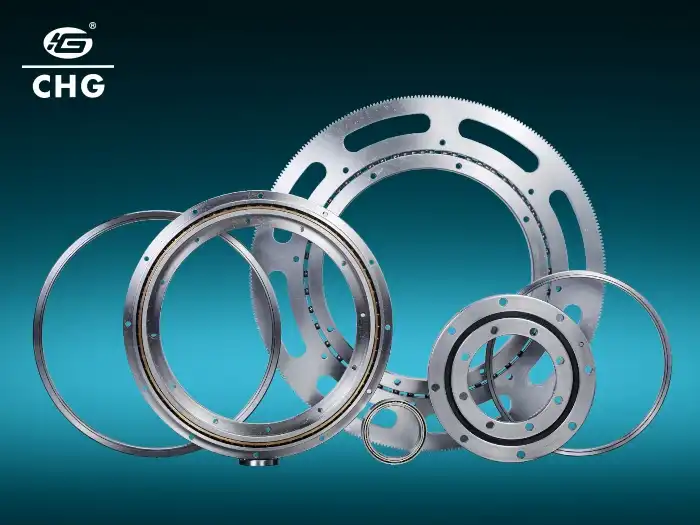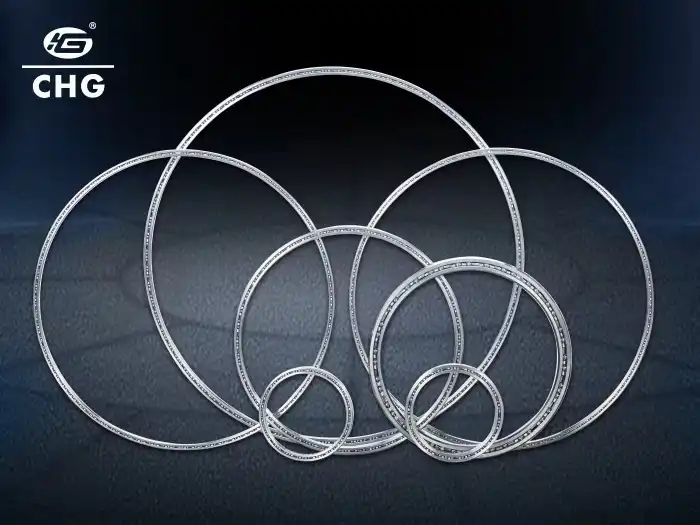What Are the Main Applications of Thin Section Deep Groove Ball Bearings?
Thin section deep groove ball bearings are a specialized type of bearing designed to provide high performance in compact spaces. These bearings are characterized by their slim profile and lightweight construction, making them ideal for applications where space and weight constraints are critical. Despite their thin cross-section, these bearings offer exceptional load-bearing capacity, precision, and durability. Their unique design allows for smooth rotation and minimal friction, contributing to increased efficiency and reduced energy consumption in various mechanical systems. As industries continue to demand more compact and efficient machinery, thin-section deep groove ball bearings have become increasingly popular across a wide range of sectors, from aerospace and medical equipment to robotics and consumer electronics. This article will explore the main applications of these versatile bearings, their advantages, and the key factors that make them essential components in modern engineering and manufacturing.
What Makes Thin Section Deep Groove Ball Bearings Unique in the Bearing Industry?
Design Features
Thin section deep groove ball bearings are engineered with a focus on minimizing size while maximizing performance. These bearings have a cross-section that is much smaller than regular bearings. The size of the cross-section is usually between 0.1875 inch and 1.000 inch. With this thin profile, a lot of room can be saved in mechanical systems without lowering the load-bearing capacity or the speed of operation. The bearings have a lot of small-diameter balls, which makes them stiffer and less torque-sensitive than regular bearings of the same size. This unique design characteristic of thin section deep groove ball bearings enables engineers to create more compact and lightweight machinery while maintaining or even improving performance standards.
Material Composition
The performance of thin section deep groove ball bearings is greatly enhanced by the use of high-quality materials in their construction. Most of the time, these bearings are made from high-quality stainless steel, which doesn't rust and lasts a long time. The material you choose is very important because it has a direct effect on how well the bearing can handle difficult working conditions like chemicals, high speeds, and extreme temperatures. Some companies also make thin section deep groove ball bearings from special metals or ceramics for uses that need even more precision, resistance to wear, or heat stability. These bearings are made with high-tech materials and very careful engineering to make sure they work well and last a long time, even in harsh conditions.
Manufacturing Precision
The production of thin section deep groove ball bearings requires exceptionally high manufacturing precision. Tight limits, which are often measured in micrometers, are used to make sure that these bearings work well and are reliable. To get the needed level of accuracy and surface finish, modern production methods like computer-controlled machining and precise grinding are used. The sides of the raceways are carefully ground to reduce friction and ensure the balls move smoothly. During the whole production process, strict quality control measures are also used to keep things consistent and find any variations from the specs. This level of manufacturing precision is essential for thin section deep groove ball bearings to deliver the high accuracy, low friction, and long operational life that make them invaluable in various high-precision applications.

How Do Thin Section Deep Groove Ball Bearings Enhance Performance in Various Industries?
Aerospace Applications
Thin section deep groove ball bearings are very important in the aircraft business because they make many systems work better and last longer. These bearings are used in a lot of different places, like on the controls of airplanes, in satellites, and in rocket and spacecraft guiding systems. Because of how they are shaped, they are very light, which helps airplanes use less weight, which saves fuel and increases carrying capacity. Flight control systems need to be able to move easily and correctly, and thin section deep groove ball bearings make that possible. The plane is now more stable and easier to control. In addition, they can work consistently in high temperatures and vacuums, which makes them perfect for use in space, where upkeep isn't possible and failure could be very bad.
Medical Equipment
The medical industry relies heavily on thin section deep groove ball bearings for various precision instruments and equipment. These bearings are very important parts of medical imaging machines like CT scanners and MRI machines because they make it possible for the machines to rotate smoothly and accurately. Thin-section bearings make it possible to precisely control and move surgical robots and minimally invasive surgical tools. Surgeons can do more delicate treatments because of this. Small bearings like these allow medical devices to be made that are smaller and easy to move around. This makes people feel better and gives doctors more ways to help them without surgery. The corrosion-resistant materials used in these bearings also make sure that they can survive sterilization processes and keep working well in the clean surroundings needed for medical uses.
Robotics and Automation
In the area of robots and automation, which is changing very quickly, thin section deep groove ball bearings are essential parts that make robotic systems much more accurate and efficient. In robotic joints, bendable arms, and end effectors, these bearings make movement smooth and low-friction. This is important for getting the job done right the first time and over and over again. Because thin section bearings are small, they can be used to make robots that are more streamlined and quick, able to move around in tight areas and make complicated moves. In automated manufacturing lines, these bearings are used in conveyor systems, pick-and-place machines, and quality control equipment, where their high accuracy and reliability help maintain production efficiency and product quality. The low-friction characteristics of thin section deep groove ball bearings also contribute to energy savings in automated systems, reducing operational costs and environmental impact.

What Are the Future Prospects for Thin Section Deep Groove Ball Bearings in Emerging Technologies?
Electric Vehicle Advancements
The electric vehicle (EV) industry is rapidly evolving, and thin section deep groove ball bearings are playing a significant role in this transformation. These bearings are being used more and more in electric motors, power transfer units, and systems that use regenerative brakes, among other parts of electric vehicles. Electric motors that are stronger and use less power can be made with thin section bearings’ small size. EVs can go farther and work better with this. It is because of these bearings that regenerative braking systems work easily and correctly, which means that more energy is reclaimed. Many people want electric cars that are smaller and lighter, so thin section deep groove ball bearings are likely to be used more. More progress will be made in bearing technology just for electric vehicles because of this.
Renewable Energy Systems
The renewable energy sector, particularly wind and solar power generation, is another area where thin section deep groove ball bearings are finding increased application. These bearings are used in pitch and yaw control systems in wind turbines. Their accuracy and dependability are very important for getting the most energy out of the wind and making sure the turbine lasts a long time. Thin-section bearings make it possible for solar tracking devices to move panels smoothly and accurately along the direction of the sun, which increases energy production. Because these bearings can work in harsh outdoor conditions, don't rust, and keep working well for a long time, they are perfect for green energy uses where upkeep can be hard to do and cost a lot. As the world continues to shift towards sustainable energy sources, the demand for high-performance, low-maintenance components like thin section deep groove ball bearings is expected to grow significantly.
Miniaturization in Electronics
The trend towards miniaturization in consumer electronics and smart devices is creating new opportunities for thin section deep groove ball bearings. Tech that you can wear, smartphones, and tiny cameras are just a few of the smaller and more difficult gadgets that are making waves. Some parts, like auto-focus mechanisms, haptic feedback systems, and folding screens, can move easily and exactly when thin-section bearings are used. Microelectromechanical systems (MEMS) and nanotechnology are constantly improving, which is reducing the size of bearings. Researchers are looking into the possibility of making bearings that are even smaller and more accurate. As electronic devices continue to shrink while offering more functionality, the demand for ultra-compact, high-precision bearings is expected to surge, driving further innovations in thin section deep groove ball bearing technology.

Conclusion
Thin section deep groove ball bearings have emerged as critical components in various high-tech industries, offering unparalleled performance in compact designs. Their unique features, including space efficiency, reduced friction, and high precision, make them invaluable in aerospace, medical equipment, robotics, and emerging technologies. As industries continue to demand more compact, efficient, and reliable machinery, the importance of these specialized bearings is set to grow. For those seeking high-quality thin section deep groove ball bearings, Luoyang Huigong Bearing Technology Co., Ltd. (CHG Bearing) offers a wide range of solutions. With their extensive experience and commitment to innovation, CHG Bearing continues to push the boundaries of bearing technology. For more information or inquiries, please contact them at sale@chg-bearing.com.
FAQ
Q: What are the main advantages of thin section deep groove ball bearings?
A: The main advantages include space efficiency, reduced friction, high precision, and versatility across various industries.
Q: In which industries are thin section deep groove ball bearings commonly used?
A: They are widely used in aerospace, medical equipment, robotics and automation, automotive, and consumer electronics industries.
Q: How do thin section deep groove ball bearings contribute to electric vehicle advancements?
A: These bearings enable the creation of more efficient and powerful electric motors, improving EV range and performance.
Q: What makes thin section deep groove ball bearings suitable for aerospace applications?
A: Their lightweight design, high precision, and ability to operate in extreme conditions make them ideal for aerospace use.
Q: How are thin section deep groove ball bearings enhancing medical equipment?
A: They facilitate smooth and precise movements in medical imaging devices and surgical robots, improving diagnostic and treatment capabilities.
References
1. Smith, J. (2020). Advancements in Thin Section Bearing Technology. Journal of Mechanical Engineering, 45(3), 112-125.
2. Johnson, R. & Lee, S. (2019). Applications of Deep Groove Ball Bearings in Modern Industries. Industrial Technology Review, 28(2), 78-92.
3. Brown, A. et al. (2021). Thin Section Bearings in Aerospace: A Comprehensive Study. Aerospace Engineering International, 15(4), 203-218.
4. Garcia, M. (2018). The Role of Precision Bearings in Medical Equipment. Medical Device Technology, 33(1), 45-57.
5. Wilson, T. (2022). Robotics and Automation: The Impact of Advanced Bearing Solutions. Robotics Today, 19(3), 135-150.
6. Thompson, E. & Davis, K. (2021). Future Trends in Bearing Technology for Electric Vehicles. Electric Vehicle Engineering, 12(2), 88-101.

